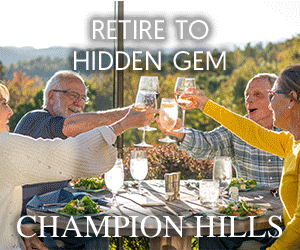The 75th anniversary of the Country Club of Johnston County was met with little fanfare in 2011.
The Smithfield club was in the process of being sold, a search was on for a new general manager and membership had dipped to alarming lows. In short, the 1936 Ellis Maples classic was at a crossroads.
And when 14 owners – a majority of them members and locals – stepped in and bought the private equity club it was unclear which direction the historic golf course was headed.
But local pride can formulate a strong bond, and the ownership team, along with new general manager Chris McDonald, weren’t about to let CCJC become another victim of golf’s corporate conglomerate.
“Those 14 individuals decided they wanted to keep the club with its home-grown roots and within the community,” McDonald said. “They were all pretty much born and raised here in Johnston County and their idea was to not give it up to a management company.”
A decision was reached to abandon the private club model and become semi-private, and to launch a unique membership drive to bolster the club’s golfing numbers and financial status. Plans are to return the CCJC to private club status in the future,” McDonald said.
“The owners did something that I was a little leery of at first with the dues structure this year that was $250 a month, including carts,” McDonald said. “But that has definitely helped increase the membership, picking up 30-35 members right away.
“The pitch always comes back to the product,” he added. “If you have a product people want you can sell it. If you have a mediocre product then it’s that much harder to sell. Once people came out and saw what we were offering, $250 a month with carts included, and then saw the product we had to offer they fell in love with the place.”
And CCJC has quite an informal pitch man. PGA Tour pro Neal Lancaster, born and raised in Johnston County, practices and plays here on a regular basis, residing a pitching wedge away on scenic Holt Lake.
“Anytime you have a PGA Tour player associated with a club it can’t do anything but help the club marketing-wise,” said McDonald, noting that the club has produced a number of top players through the years, including 2009 North Carolina Amateur champion Mark McMillen.
“I’ve played at the course since I was 15 years old,” Lancaster said. “The new owners are really looking after the golf course now and getting a lot of membership play. Things have really taken off … they even had to get some more carts recently.”
While CCJC has a pool, tennis courts and a traditional ballroom in its white brick clubhouse, the Maples golf course is the main draw. The Hall of Fame architect learned his design style from the legendary Donald Ross, working with the lay of the land to produce everlasting routing.
The Country Club of Johnston County is vintage Maples, routing holes from high point-to-high point while implementing doglegs for strategic value. And while not long by today’s standards at 6,573 yards, the course is “sneaky difficult” with sloping greens that require accurate iron play throughout.
“It is definitely a shot-maker’s course,” McDonald said. “Ellis Maples was a real tactician.”
“It’s a golf course that is playable, and fun to play every day,” added 68-year-old Bob Borsos, who joined the club in 1977 after moving to the area from Milwaukee. “The greens are unusual for this area; they have a lot of undulation. When you look at the course there are some subtleties out there that make it great. You don’t bomb it off of every tee because if you do you’re in trouble, you’re off in the woods or in a pond or someplace other than where you want to be.”
CCJC is a golf course you could play in three hours, with a walk between green and next tee sometimes as little as 5 yards. Maples also crafted a series of par-3s that play to four different distances – 205, 170, 184 and 217 – meaning players use their entire bag here.
“It’s very similar to a Donald Ross golf course,” Lancaster said. “The greens have some of the old-style undulation where newer greens have more tiers to them. The greens here actually have a lot more break than most of the greens we play on Tour. You have to drive it straight and it takes a little bit of local knowledge to score well.”
Golf rounds in North Carolina are up 11 percent in 2012, thanks in part to a warmer-than-normal winter, but CCJC’s rebirth has the club exceeding those numbers, and McDonald may have found his dream job despite a commute from the Sandhills that exceeds three hours each day.
“I wasn’t sure what to think when I first got here,” McDonald said. “I did know that they had a good product and a good golf course and a good architect. Ellis Maples is pretty big in the Sandhills. I knew once the golf course was in good shape then I was 50 percent there. The other 50 percent of increasing the membership and getting the membership back has finally come around. Our member-guest last year had 23 teams; this year we had 42 teams.
“The whole ownership has been very supportive to do what I needed to get done so we could get the property on the right track.”
McDonald likes to spread the credit around for the club’s turnaround, noting that golf pro Tony Keeton has a tremendous following when it comes to lessons and offers custom club-fitting on-site for golfers of all ages and abilities, using state of the art equipment such as a Flightscope X2 Launch Monitor and high-speed video. A comprehensive junior program is also in the works.
“In reality you don’t see many of these small town country clubs anymore,” McDonald said. “Golf is more corporate now, but there is also a niche out there for places like the Country Club of Johnston County. It’s a throwback. This is the place to be.”

















